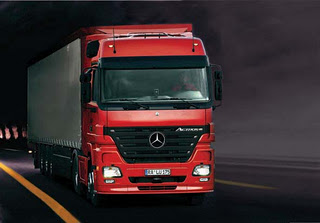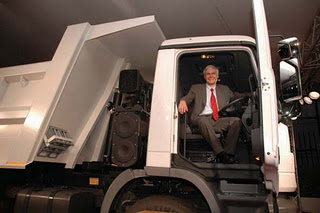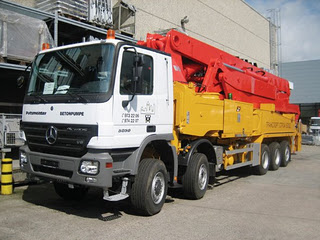 Mercedes Benz, the world’s largest truck and bus manufacturer, is drawing aggressive plans for expanding its product range in the Indian market. After putting over 200 Actros tippers on the road, Mercedes is preparing for its next big step. “We are expanding our product portfolio and looking at launching trucks for the long haulage and construction segment”, said Dr. Wilfred Aulbur, Managing Director of Mercedes Benz India Private Ltd. (MBIPL). This is apart from the luxury buses which the company plans to launch during the second half of 2008.
Mercedes Benz, the world’s largest truck and bus manufacturer, is drawing aggressive plans for expanding its product range in the Indian market. After putting over 200 Actros tippers on the road, Mercedes is preparing for its next big step. “We are expanding our product portfolio and looking at launching trucks for the long haulage and construction segment”, said Dr. Wilfred Aulbur, Managing Director of Mercedes Benz India Private Ltd. (MBIPL). This is apart from the luxury buses which the company plans to launch during the second half of 2008. 
Dr. Aulbur is a strong believer in the Indian growth story. He says: “A strong economy with an expected GDP growth rate of 6 to 8% each year over the next 10 years and the Government’s commitment towards investments for infrastructure growth would drive demand for commercial vehicles in general and also for our type of vehicles (European Concepts) in particular. We are quite confident that the commercial vehicle market in India in its various segments will witness significant growth in the coming years”.
Mercedes Benz India made its entry into the Indian commercial vehicle industry with the launch of the Actros Tipper in 2006. It sold 51 units in the first year and 157 units in the next. The company offers a 6X4 and an 8X4 tipper model for heavy duty applications.
Dr. Aulbur says: “The customer experience with the Actros on the field has been very positive. He prefers the Actros due to its high quality performance and low operating cost. Based on the success with the Actros, we are looking at a few segments like tractor trailers for the long haulage and ODC (Over Dimensional Cargo) transportation and trucks for the construction industry”.
In fact, the parent company, Daimler AG, and the Hero Group recently announced plans to set up a joint venture company, Daimler-Hero India Private Ltd., for manufacturing commercial vehicles in India. Media reports indicate that the new JV will set up its manufacturing facility near Chennai. There is no official confirmation as yet. However, the new JV has nothing to do with the existing commercial vehicle business of Mercedes Benz India.
The Daimler-Hero JV and Mercedes Benz India Private Ltd. will operate in two different segments in the commercial vehicle industry. Mercedes Benz India will cater to the top end of the segment, particularly high-end tippers and tractor trailers, and the new JV will focus on the mass segment, namely, the medium and entry level heavy commercial vehicle space. The new JV will produce everything along the value chain, and these products will be tailored to the Indian market.
Product expansion
The commercial vehicle industry can be categorized into two main segments. One is the mass segment which is mostly medium to basic heavy duty vehicles, and then we have the high end segment like tractor trailers and the heavy duty tipper segment. The high end products are performance-driven and are known by what the industry calls “Total cost of ownership”.
The initial investment on these products can be high, but the total cost of ownership during the lifetime of the product is much less compared to other normal trucks and tippers. This is due to the high performance levels, lower fuel consumption and reduced maintenance cost of these vehicles.
In India, the high end tipper segment, particularly used in mines, is being catered to by the European brands like Volvo, Mercedes and Scania. Indian companies like Tata Motors, Ashok Leyland and AMW have also launched a few products in this segment, but they are yet to match the performance levels of the European trucks.
“There are several areas in India like mining, construction and long haulage application where European trucks can play an important role. We are looking at any segment where the total cost of ownership will be a key factor”, says Dr. Aulbur.
The next segment which is moving towards European concepts is the long haulage tractor trailers and ODC carriers. This segment offers tremendous opportunity for growth as it is the fastest growing within the commercial vehicle industry.
With better road infrastructure and connectivity between metros, this segment will witness exponential growth. Volvo has a limited presence in this segment selling its FH models. Mercedes sees a good opportunity for its vehicles in this segment, particularly for heavy duty applications.
The ODC carrier is another niche segment which offers good opportunity for Mercedes trucks. This segment traditionally used heavy duty European tractors as it requires very high power, reliability and safety. The total market size for ODC carriers is expected to be around 3,000 units, and this is again a segment which Mercedes plans to target.
Construction is another interesting area where Mercedes sees an opportunity for its products. Dr. Aulbur indicated that the company is looking at the market for products like the Boom pumps and concrete mixers for limited applications. Typically boom pumps are used on most of the larger construction projects as they are capable of pumping concrete of very high volumes. With the ongoing boom in infrastructure and construction industry, this could be an interesting product offering.
Both the tractor trailer and boom pumps will be on the Actros platform. “At the end of the day, our trucks should make money for our customers when compared to the other trucks available in the market”, according to Dr. Aulbur.
Manufacturing
In 2006 when the Actros tipper was launched, Mercedes initially imported the vehicle as completely built units (CBUs). It was only in 2007 that the company started importing the vehicle in completely knocked down (CKD) kits and started assembling them at the existing plant.
“We are in the process of building a commercial vehicle assembly line at the new facility at Chakan near Pune where we will manufacture both trucks and bus chassis. Initially we will have a capacity to manufacture 1,200 units in one shift, and this can be raised to 3,600 units as per the market requirement. Currently, we have about 20 per cent local content: mainly components like batteries and wheel rims. We expect the process of localization to continue. However, since the volumes are not very high, it may not make sense to manufacture certain critical parts locally. There is no plan for indigenisation as far as powertrain and drive lines are concerned”, he adds. 
Bus segment
In 2007 Mercedes Benz India announced its plans to make an entry into the fast growing luxury bus business. The company has tied up with Sutlej Motors of Jullandhar for building bus bodies. The collaboration of Mercedes Benz India and SML covers areas like development, production, marketing, sales and after-
sales of luxury rear engine coaches. The Mercedes-Benz chassis will be manufactured at the existing manufacturing facility and eventually at the new facility at Chakan. The body will be built by SML. Mercedes Benz India will then handle sales and after-sales of the coaches.
Mercedes has already received the ARAI approval for the bus it plans to launch in the Indian market. Sutlej Motors is setting a separate body and finish lines for building bus bodies as per Mercedes standards.
Dr. Aulbur observes: “Our bus venture is in progress as scheduled. We are working closely with Sutlej to ensure that the buses conform to Mercedes Benz standards. Clearly the bus segment requires a lot of work to ensure that the buses live upto the quality expectations of our customers. We would be launching the buses in the second half of the current year”.
With improved road network in the country and increasing need for efficient public transport systems, the demand for high-end buses is expected to grow. The country will require buses that ensure comfort and convenience of the passenger and at the same time provide the highest degree of safety and environmental performance.
Volvo set new standards and raised the bench mark when it launched its luxury buses five years back. With the entry of Mercedes, the luxury bus segment will clearly move to the next level in terms of design, technology, safety and performance. Indian CV majors like Tata Motors and Ashok Leyland are also gearing up for the challenge and are working quite aggressively on their bus platform. The city bus segment in India is undergoing significant changes in terms of technology and design. But the initial focus for Mercedes will be on the coach segment, while the city bus segment will come into focus at a later stage. The company is already in discussion with a few State Transport Corporations and private customers for its coaches, and the first few units are expected to roll out in the second half of 2008.
Asked about the export opportunities for trucks and buses from India, Dr. Aulbur made it clear that there is no immediate plan for exporting commercial vehicles from the country. India as a market offers enough opportunities for growth in the next few years and exports are not in the focus at the moment. 
Sales and service network
Dr. Aulbur accepts that after-sales service will be a key element for the success of any product. “We believe that a careful entry into the market is what is required, so that we can make sure that our products perform well and that we provide after-sales and service. For the truck segment we already have 6 service locations. In the bus segment we will focus on specific routes initially and will ensure that we have a well-defined service network along these routes. We have currently identified 3 locations so far, and want to make sure that our service is upto what our customers expect”.
Reacting to the overall dip in sales in the truck industry during 2007-08, Dr. Aulbur said that the fall in sales in the medium and heavy truck segment needs to be looked at in the context of the huge growth of 30% registered the previous year. The market added a huge tonnage, and it is quite normal that a small correction takes place after nearly 5 years of sustained growth. The short-term dip is a temporary phenomenon. However the long-term growth prospects remain strong.
“We are growing faster than we expected on the tipper business, and see a good growth opportunity for our products in India. Last year we had 18 per cent marketshare, and we hope to add to it in the current year”.
In conclusion, Dr. Aulbur said: “It’s going to be exciting to see how the industry will develop in the future. Overall India has enormous growth potential in different segments of the transport industry. As one of the leading global manufacturer with strong growth in emerging markets, we hope to replicate our success in India as well”.